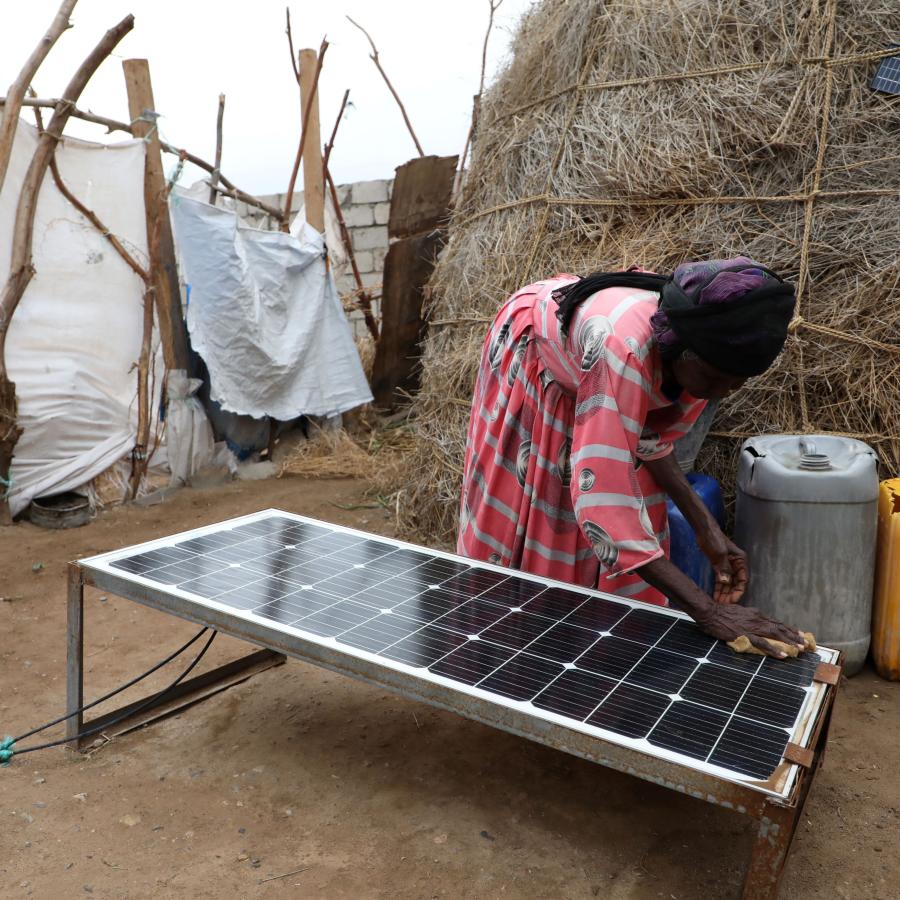IOM YEMEN: LIGHTING THE WAY (The Impact of Solar Energy on Displaced Communities in Yemen)
Al Khukhah, Yemen
They say there’s no place like home. For most people, home is where you feel safe, secure, and comfortable. Years ago, all Zahra ever dreamt about was staying warm in her humble dwelling, surrounded by her beloved grandchildren. Little did she know that she would end up spending her senior years in a displacement site.
“When the clashes escalated, people were forced to flee, leaving behind all of their cherished belongings,” Zahra recounts with a heavy heart.
Fearing for her safety, Zahra and her family relocated to the Al Dehywi displacement site in Al Khukhah, Al Hodeidah in western Yemen. Yet, like other displacement sites, Al Dehywi site lacked even the most basic services.
At night, the area was shrouded in darkness, raising protection concerns for families who were hesitant to let their children venture outside. Additionally, without electricity, it was challenging for families to carry out their daily activities within their shelters.
DARKNESS IN DISPLACEMENT
The power shortage in Yemen has reached unprecedented levels, a situation further compounded by the conflict and limited access to energy resources such as fuel and diesel. This blackout has placed a heavier burden on displaced people, who rely solely on lanterns or flashlights to navigate at night.
The lack of electricity in the Al Dehywi displacement site has exposed extremely vulnerable groups such as the elderly, children, and disabled individuals, to various forms of harm, neglect, and other adverse events.
“I can only see with one eye, so I cannot navigate properly at night,” explains Zahra. “I’ve fallen several times as I tried to get from one place to another.”
Children and elderly people like Zahra have had to depend on their adult relatives to accompany them to access the latrine or move across displacement sites at night, a task that grants them neither the independence nor the freedom they need.
ENERGY CRISIS
Not far from Zahra and her family lives Zaid with his wife, Saeedah, and their four children – a family that has also grappled with the absolute darkness.
“Since the beginning of the conflict, both the inside and outside of our shelters looked the same; everything was cloaked in darkness at night,” recalls Ziad. “In the past, we relied on lanterns and traditional flashlights powered by consumer batteries, but they were not very convenient.”
The scarcity of energy poses a serious challenge in displacement sites in Al Khukhah, where many families shelter. To address the pressing need for energy in spontaneous displacement sites in Al Khukhah, especially Al Dehywi and Al Shaihal, the International Organization for Migration (IOM) has provided over 1,172 solar power systems to maintain the safety and dignity of community members.

SOLAR TRANSFORMATION
Under the guidance of IOM’s Camp Coordination and Camp Management team, maintenance committees have played a significant role in supporting families living in the sites by installing solar systems, which include a solar battery, panel, and electricity inverter. Additionally, IOM teams conducted awareness-raising sessions to help displaced families, like Zaid’s, learn how to properly use and maintain the solar systems.
The introduction of these new solar systems has had a profound impact on the lives of families, significantly improving their ability to navigate through the night.
“Most of the men here work as fishermen, which often keeps them away from their families for days at sea,” explains Ayman Sultan, IOM Field Assistant in Al Khaukhah. “One of their major concerns while away was not being able to stay connected with their families. Now, with the solar systems, the problem has been resolved as they can recharge their phones.”
NIGHTTIME COMFORT
Women have also expressed a newfound sense of security, as the solar lighting allows them to see the surroundings of their shelters and guard against animals and insects.
“Before the distribution of solar systems, most families relied on a single flashlight, which proved inconvenient,” remarks Alallah Besharah, a Community Mobilizer in Al Dehywi site. “When women needed to prepare food, they had to take their children to the kitchen, exposing them to potential burns.”
“The situation has vastly improved now that the solar systems can provide ample lightning to cover the shelters, kitchens, latrines, yards and beyond,” he adds.
Alallah explains that given the hot weather in Al Khukhah, displaced people endured discomfort throughout most of the year. People often resorted to sprinkling water around their shelters and on the ground to alleviate the heat, yet sleeping in such conditions remained a daunting task. However, the installation of solar systems has transformed their circumstances, allowing people to cool their shelters using fans.
“Now, even after nightfall, we are able to carry on with our lives as usual. We no longer worry about preparing dinner or blending food for our babies,” says Saeedah.
“The light extends to areas outside the shelter, giving us the courage to visit our relatives living in neighbouring shelters. Our children can now sleep more soundly, feeling safe now that it is no longer dark.”
Through the project, IOM has been able to implement numerous sustainable projects in displacement sites across Al Khukhah district, aiming to enhance the overall living conditions of displaced people in the area. IOM remains steadfast in its commitment to implementing sustainable solutions, ensuring people have access to eco-friendly lighting resources.



